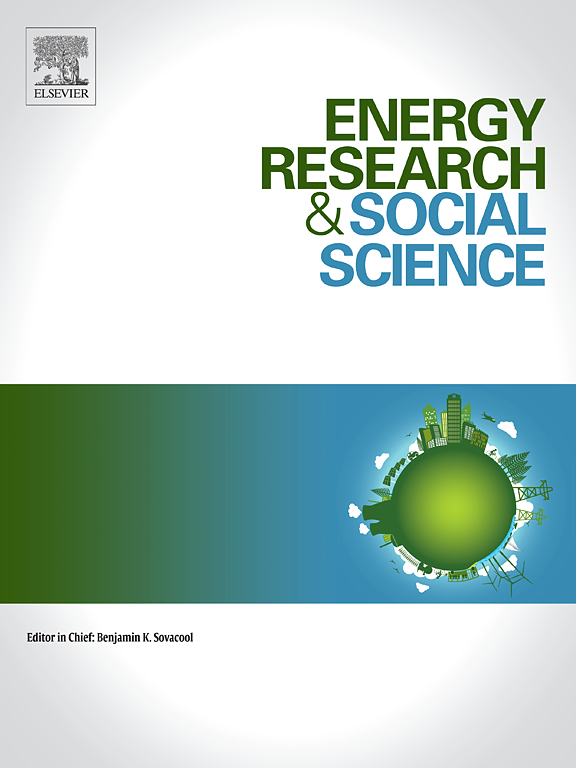加速低碳转型:见解、概念、挑战和新的研究方向
IF 7.4
2区 经济学
Q1 ENVIRONMENTAL STUDIES
引用次数: 0
摘要
考虑到一些低碳转型正在加速,我们对加速的驱动因素、条件、机制和动态能说些什么?这个问题在政策和学术界被广泛讨论,但到目前为止,很少有人试图提出一个更全面的答案,考虑什么是加速,它是如何产生的,以及如何研究它向前发展。为了提供一种更全面的方法来研究加速现象,本文提供了一个棱镜视角,它调动了几个社会科学学科和领域的见解,这些学科和领域已经参与了加速,并将它们与可持续性转型联系起来。本文的目标有三个:绘制出有助于更好地理解或解释加速的概念或工具;反思突出的主题和题目;并找出研究空白和富有成效的方向。由跨学科和权威的作者团队撰写,本文借鉴了广泛的概念,包括但不限于政治学的反馈理论,商业和管理文学中的在职者重新定位和创新竞赛,社会文化研究中的文化理论和公众接受,以及消费研究和社会学的见解。它利用这个语料库来确定加速的五个单一维度(经济、技术、商业、政策和行为/文化)以及四个多维机制(引爆点、多系统交互、阈值动态和深度杠杆点)。然后,在综合观点和绘制未来研究方向之前,研究了潜在的驱动因素和对加速的理解。本文章由计算机程序翻译,如有差异,请以英文原文为准。
The acceleration of low-carbon transitions: Insights, concepts, challenges, and new directions for research
Given that several low-carbon transitions are now accelerating, what can we say about the drivers, conditions, mechanisms, and dynamics of acceleration? This question is widely discussed in policy and academic circles, but so far there is little attempt to develop a more comprehensive answer that considers the pluralistic and heterogeneous nature of what acceleration is, how it comes about, and how it can be studied moving forward. To provide a more comprehensive approach to the phenomenon of acceleration, this paper offers a prismatic perspective that mobilizes insights from several social science disciplines and fields that have engaged with acceleration and links them to sustainability transitions. The objectives of the paper are threefold: to map out concepts or tools that are useful for better understanding or interpreting acceleration; to reflect on prominent themes and topics; and to identify research gaps and fruitful directions. Written by an interdisciplinary and authoritative team of authors, the paper draws from a wide range of concepts including but not limited to feedback theory from political science, incumbent reorientation and innovation races from business and management literature, cultural theory and public acceptance from socio-cultural studies, along with insights from consumption studies and sociology. It draws on this corpus to identify five singular dimensions of acceleration (economics, technology, business, policy, and behavior/culture) as well as four multi-dimensional mechanisms (tipping points, multi-system interactions, threshold dynamics and deep leverage points). It then examines underlying drivers and understandings of acceleration before synthesizing perspectives and charting directions for future research.
求助全文
通过发布文献求助,成功后即可免费获取论文全文。
去求助
来源期刊

Energy Research & Social Science
ENVIRONMENTAL STUDIES-
CiteScore
14.00
自引率
16.40%
发文量
441
审稿时长
55 days
期刊介绍:
Energy Research & Social Science (ERSS) is a peer-reviewed international journal that publishes original research and review articles examining the relationship between energy systems and society. ERSS covers a range of topics revolving around the intersection of energy technologies, fuels, and resources on one side and social processes and influences - including communities of energy users, people affected by energy production, social institutions, customs, traditions, behaviors, and policies - on the other. Put another way, ERSS investigates the social system surrounding energy technology and hardware. ERSS is relevant for energy practitioners, researchers interested in the social aspects of energy production or use, and policymakers.
Energy Research & Social Science (ERSS) provides an interdisciplinary forum to discuss how social and technical issues related to energy production and consumption interact. Energy production, distribution, and consumption all have both technical and human components, and the latter involves the human causes and consequences of energy-related activities and processes as well as social structures that shape how people interact with energy systems. Energy analysis, therefore, needs to look beyond the dimensions of technology and economics to include these social and human elements.
 求助内容:
求助内容: 应助结果提醒方式:
应助结果提醒方式:


